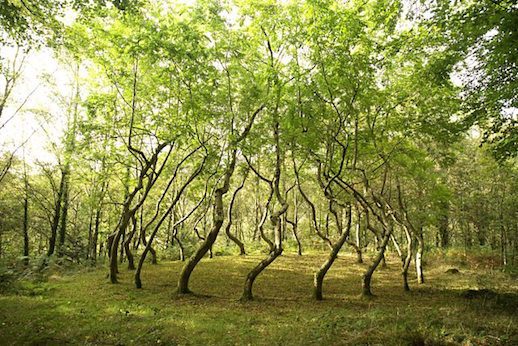Dr James Fox MA (Cantab), MPhil, PhD is a Fellow at Gonville & Caius College in Cambridge. An author and TV presenter with a special interest in the art of WW1, 20th century art and the cultural history of colour, it’s land art that has become the focus of his most recent documentary for BBC Four.
Forest, Field & Sky: Art Out of Nature follows six landscapes and the work of David Nash, Andy Goldsworthy, Julie Brook, Richard Long, Charles Jencks and James Turrell. From a flaming beacon in the outer Hebrides to the art of the long walk in Exmoor, Dr Fox looks at the way we create art from nature, the marks we leave on the landscape and how it can inspire a different way of thinking about modern art and the world around us. Lara C Cory chats to him about the programme.
 David Nash’s “Ash Dome”
David Nash’s “Ash Dome”
You mention in your documentary that you were attracted to this sort of art since you were a boy. Can you tell me about this?
I was fascinated by the natural world as a boy. Armed with a library of Usborne books that my father had given me, I taught myself everything about the flora and fauna of Britain. I took particular delight in drawing birds and flowers in painstaking detail. For me, every natural thing was a masterful work of art in its own right. I wondered, for instance, about the skill that went into the making of a bird’s nest. As I grew older, I sought out artworks that also existed out of doors, and had that same silent beauty as the world in which they found themselves.
Can you tell me about one of the lingering highlights from making of Forest, Field & Sky: Art out of Nature?
The making of Forest, Field & Sky was full of highlights. We took the best part of a year to film it — so rare in today’s fast-paced production schedules — and really tried to absorb the landscapes we visited.
The most memorable shoot was probably our visit to the outer Hebrides to see Julie Brook make a firestack. I didn’t think such remote places existed in the UK! From Cambridge, where I live, I had to fly to Glasgow, then take a train to Inverness, then fly to Stornoway, then drive 2 hours to the end of the road on the Isle of Lewis, then get into some 4x4s and drive another two hours across mud tracks, and then hike a further hour across the hills to get to the place where Julie made her piece. It took me two days to reach her. But the experience itself was worth the effort. I will never forget the moment Julie lit up that fire-stack.
Did you have a favourite, and why?
I suppose my favourite artwork in the programme is David Nash’s Ash Dome. I’d seen a photograph of that piece when I was a boy, but remember being told that it was in a secret location. I’d resigned myself to never seeing it, until this project came along. David Nash took me there personally, and he had a big, proud grin on his face when he made the big reveal. I can’t describe how moving I found the experience. It’s not simply because of the beauty of the piece; I found it genuinely humbling that this was a work that he’d been devoted to for almost forty years of his life. He’d been working on Ash Dome for longer than I’d been alive!
What’s the most significant feeling or thought that you took from this particular journey?
Again and again, these artists reminded me that it is not only foolish, but also dangerous to see ourselves as somehow different from nature. Humans are nature. Even the acts that we so often consider to be the opposite of nature, culture, are the result of our working with the natural world. If we start to see our environment as just as much of a masterpiece as our finest artworks, perhaps we’ll treat it with the same care and reverence as we do the paintings and sculptures in our museums.
Why is this sort of art so important today?
This kind of art is important partly because it disproves many of the common criticisms of contemporary art. So many people have come up to me and told me that modern art is ugly, lacking in craft, a money-spinning con-trick, targeted at a wealthy urban elite. Well this kind of art is the opposite of all that. It’s exceptionally beautiful, requires a huge amount of care and attention, and can’t be bought or sold. It’s there for anyone to go and see, usually free of charge. It’s also extremely appealing to children who love to be outdoors, so it can help get the next generation become interested.
What was the catalyst to make Forest, Field & Sky?
I’ve always wanted to make a film about Land Art. I’ve pitched it to the BBC for years and years. And while they’ve always been interested, it never quite happened. So when early last year there was a glimmer of an opportunity, I pounced. I’m delighted I did!
Forest, Field & Sky: Art Out of Nature is available to watch on BBC iPlayer for another 9 days.